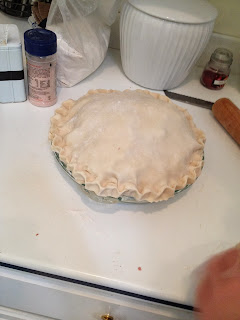A quick definition of pasty, from our friend Wikipedia:
"A pasty (sometimes known in the United States as a pastie or British pasty) is a baked pastry, a traditional variety of which is particularly associated with Cornwall, the westernmost county in England. It is made by placing uncooked filling typically of meat and vegetables, without meat in vegetarian versions, on a flat pastry circle and folding it to wrap the filling, crimping the edge to form a seal. After baking, the result is a raised semicircular comestible." (visit source to read the rest of the history of the pasty)Thus a traditional pasty is like the Italian calzone - pastry folded over a savory filling in a half-moon shape (the Italian calzone is, of course, made with pizza dough instead of pie dough). The recipe below is for a pie-dish version, but the essential concept is the same.
Pasty
Ground beef, raw
Peeled, sliced potatoes (about 1/8" thick)
Peeled, sliced carrots (about 1/8" thick)
Chopped onion
Peeled, sliced rutabagas (about 1/8" thick) - drained, canned ones can be substituted (these are very difficult to peel and slice. It is easier if you cut it in quarters at least and microwave it for a couple of minutes)
Salt and Pepper to taste
One double crust pastry
Directions:
Into an unbaked pie shell put the filling ingredients all mixed up together. There should be enough filling mix to very comfortably fill the pie shell and maybe even form a short mound on the top. As a shortcut, one can partially cook the vegetables ONLY, in the microwave. As for proportions, it depends on how big the pie is you want to make. For example, for a 10" pie plate, you want at least 1/2 lb. to 3/4 lb. of ground beef, approx. 5 large potatoes, 4 large carrots, 1 small onion, and 1/2 of a rutabaga. Over the filling ingredients, add 1/4 cup water and place the upper pie crust and secure the edges. Bake in a 350 degree oven for 50-60 minutes, or until the vegetables are tender when pierced with a fork.
|
In the above recipe, I find the filling recommendations to make a bit much for one pasty, so use your best judgment.
When I made the pasty this past time, I was especially over-enthusiastically zealous with filling, resulting in a pie filled with enough filling for at least two pasties. I baked it anyway, being too lazy to stop and make another pie crust, and the end result was that I drastically undercooked it, ending up with crisp-tender vegetables - not what one wants for a pasty. Thus, make sure that you're not overfilling the pie, and be sure to cook completely!
One tip for making pasty-making easier is to do your mise-en-place ahead of time. Dice your vegetables, thaw your meat, and assemble your pie dough early - the morning of or the night before. When you do that, assembling the pasty is a matter of just a few minutes, and mess-free! If you leave everything to the evening-of, things are likely to be both messy and time-consuming.
I can't overstate how awesome this dish is - I'm already planning to make it again when we have Christmas house-guests!
(While doing research for this dish, I found that there is actually a restaurant devoted to pasty - and it's located five minutes away from us in Tempe! Is that awesome, or what? Check it out - The Cornish Pasty Company! Yum. I sense a culinary field trip in our near future.)
Enjoy!


No comments:
Post a Comment
I love to hear from you! All kind and thoughtful comments will be published; all inconsiderate or hurtful comments will be deleted quietly without comment. Thanks for visiting!